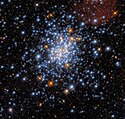NGC 330
| NGC 330 | |
|---|---|
 | |
| Bild på NGC 330 tagen med Rymdteleskopet Hubble. | |
| Observationsdata | |
| Stjärnbild | Tukanen |
| Noterbart | Tillhör Lilla magellanska molnet |
| Upptäckt | |
| Upptäcktsår | 1 augusti 1826 |
| Upptäckare | James Dunlop |
| Andra beteckningar | |
| Dun 23, ESO 29-SC24, GC 183, Lindsay 54, Kron 35, h 2367 | |
| Se också: Klotformiga stjärhopar, Lista över klotformiga stjärhopar | |
NGC 330 är en klotformig stjärnhop i Lilla magellanska molnet i stjärnbilden Tukanen. Den upptäcktes den 1 augusti 1826 av James Dunlop.
Källor
- Den här artikeln är helt eller delvis baserad på material från tyskspråkiga Wikipedia, NGC 330, 11 januari 2015.
| ||||||||||||||
Media som används på denna webbplats
Författare/Upphovsman:
Credit:
ESA/Hubble & NASA, J. Kalirai, A. Milone, Licens: CC BY 4.0A Scattering of Stars
This Picture of the Week depicts the open star cluster NGC 330, which lies around 180,000 light-years away inside the Small Magellanic Cloud. The cluster — which is in the constellation Tucana (The Toucan) — contains a multitude of stars, many of which are scattered across this striking image.
Pictures of the Week from the NASA/ESA Hubble Space Telescope show us something new about the Universe. This image, however, also contains clues about the inner workings of Hubble itself. The criss-cross patterns surrounding the stars in this image — known as diffraction spikes — were created when starlight interacted with the four thin vanes supporting Hubble’s secondary mirror.
As star clusters form from a single primordial cloud of gas and dust, all the stars they contain are roughly the same age. This makes them useful natural laboratories for astronomers to learn how stars form and evolve. This image uses observations from Hubble’s Wide Field Camera 3, and incorporates data from two very different astronomical investigations. The first aimed to understand why stars in star clusters appear to evolve differently from stars elsewhere, a peculiarity first observed by the Hubble Space Telescope. The second aimed to determine how large stars can be before they become doomed to end their lives in cataclysmic supernova explosions.
Credit:
ESA/Hubble & NASA, J. Kalirai, A. Milone
Coordinates Position (RA): 0 56 19.74 Position (Dec): -72° 27' 58.39" Field of view: 2.55 x 2.43 arcminutes Orientation: North is 28.3° left of vertical Colours & filters Band Wavelength Telescope Ultraviolet UV 225 nm Hubble Space Telescope WFC3 Optical U 336 nm Hubble Space Telescope WFC3 Optical U 336 nm Hubble Space Telescope WFC3 Optical I 814 nm Hubble Space Telescope WFC3 Optical H-alpha 656 nm Hubble Space Telescope WFC3 Optical I 814 nm Hubble Space Telescope WFC3.

